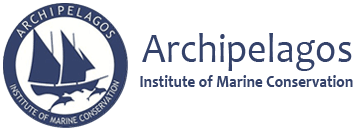I’m Imogen, a 22-year-old New Zealand intern currently in the Microplastic and Marine Mammal Team at Archipelagos on Lipsi Island. I am currently completing my masters in Evolutionary Biology via the MEME programme, with the intention to study conservation genetics in combination with field work. While my current study is officially based at Ludwig Maximilian University of Munich, my courses are online which allows me to complete my research project here concurrently with studies.
From April until August of 2022 I am involved in a self-made project at Archipelagos focussing on microplastic accumulation on seagrasses, Posidonia oceanica. This is an endemic species in Mediterranean waters and is frequently described as the ‘lung of sea’ for its vital role in CO2 sequestration and production of oxygen. P. oceanica is also a vital habitat for various aquatic individuals, from juvenile fish to fireworms. The global study of microplastics on seagrasses is a recent research interest and publications have found that seagrasses form a ‘microplastic sink’, where the disruption of current along the seafloor by grasses causes major accumulation of damaging particles.
My study is the first of its kind on P.oceanica in the Aegean and will examine the relative differences between sediment and seagrass microplastic concentrations. Due to the recency of this research field, my methods are largely experimental and may be able to contribute to new research standards. At this stage, I am comparing five sites around Lipsi Island, not only in the differences in accumulation between sediments and seagrasses but also amongst seagrass blades within single growth plots, which may relate to current flow.
Pilot studies in the lab to produce a replicable method have already observed multiple plastic fibres of different colours on a single blade of P. oceanica. This is a worrying result, for this extreme amount of plastic and undoubtedly has impacts on the surrounding biodiversity. Upon the analysis of my microplastic filters I expect to find a heightened concentration of microplastics on seagrasses facing incoming winds and tidal currents. I hope that seagrass blades in the centre of plots will have a lower concentration of plastics so local fish and invertebrate populations have a ‘refuge’ from the otherwise ever-present plastic particles.
Of course, this study is ever-expandable in its complexity and I hope studies will continue. The closer examination of anthropogenicanthropomorphic impact including water run-off or macroplastic pollution (i.e. litter presence) and its relation to microplastic accumulation in these sites will be undoubtedly useful. Extension of this analysis to locations around Samos or the greater Aegean will provide a more comprehensive picture of seagrass microplastic accumulation and its associated impacts. This project adds another aspect of seagrass health monitoring (in addition to density, depths or lengths) as completed by other teams which may have more direct consequences on biodiversity.
My general day-to-day schedule at Archipelagos varies. It has included days of snorkeling to collect samples of seagrass and sediments and working in the laboratory in order to fine-tune my extraction protocol before starting my official microplastic quantification and report production. When my research is quieter, I also frequently help with other monitoring or collection surveys, macroplastic beach collections or boat surveys to determine cetacean population health in the Aegean.
This study is perfect to gain applied research experience with like-minded individuals who are all passionate about marine life. The experience of producing my own research project with potentially field-defining results is irreplaceable.



